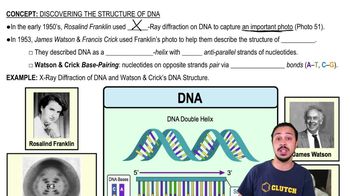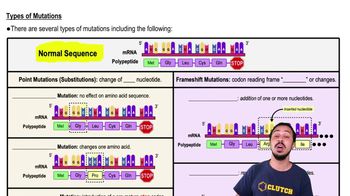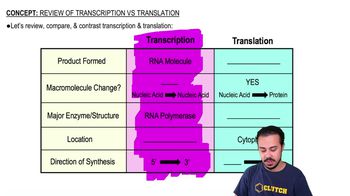Briefly describe the components of DNA, and explain its functional relationship to RNA and protein.
Ch. 2 - Chemical Principles
Chapter 2, Problem 8.4a
The following is a code for a strand of DNA.<IMAGE>
a. Using the genetic code provided in Figure 8.8, fill in the blanks to complete the segment of DNA shown.
b. Fill in the blanks to complete the sequence of amino acids coded for by this strand of DNA.
c. Write the code for the complementary strand of DNA completed in part (a).
d. What would be the effect if C were substituted for T at base 10?
e. What would be the effect if A were substituted for G at base 11?
f. What would be the effect if G were substituted for T at base 14?
g. What would be the effect if C were inserted between bases 9 and 10?
h. How would UV radiation affect this strand of DNA?
i. Identify a nonsense sequence in this strand of DNA.
 Verified step by step guidance
Verified step by step guidance1
insert step 1: Understand the structure of DNA and the genetic code. DNA is composed of nucleotides, each containing a sugar, a phosphate group, and a nitrogenous base (A, T, C, G). The genetic code is used to translate DNA sequences into amino acids.
insert step 2: For part (a), use the genetic code chart to determine the missing nucleotides in the DNA strand. Each set of three nucleotides (codon) corresponds to a specific amino acid.
insert step 3: For part (b), translate the completed DNA sequence into an mRNA sequence by replacing T with U, then use the genetic code to determine the sequence of amino acids.
insert step 4: For part (c), write the complementary DNA strand by pairing A with T and C with G.
insert step 5: For parts (d) to (i), analyze the effects of mutations and environmental factors on the DNA sequence. Consider how substitutions, insertions, and UV radiation can alter the sequence and potentially create a nonsense sequence.

Verified Solution
Video duration:
5mWas this helpful?
Key Concepts
Here are the essential concepts you must grasp in order to answer the question correctly.
DNA Structure and Function
DNA (deoxyribonucleic acid) is a double-stranded molecule composed of nucleotides, each containing a sugar, a phosphate group, and a nitrogenous base (adenine, thymine, cytosine, or guanine). The sequence of these bases encodes genetic information, which is transcribed into RNA and translated into proteins. Understanding the structure of DNA is crucial for analyzing mutations, complementary base pairing, and the overall genetic code.
Recommended video:
Guided course

Discovering the Structure of DNA
Mutations and Their Effects
Mutations are changes in the DNA sequence that can occur due to various factors, including substitutions, insertions, or deletions of nucleotides. These alterations can lead to different effects on protein synthesis, ranging from silent mutations (no effect) to missense mutations (change in amino acid) or nonsense mutations (premature stop codon). Analyzing the impact of specific mutations is essential for understanding genetic diseases and evolutionary processes.
Recommended video:
Guided course

Types of Mutations
Transcription and Translation
Transcription is the process by which the DNA sequence is copied into messenger RNA (mRNA), which then undergoes translation to synthesize proteins. The genetic code, consisting of codons (three-nucleotide sequences), determines the specific amino acids that are assembled into proteins. A solid grasp of these processes is necessary to complete the tasks related to filling in amino acid sequences and understanding the implications of mutations on protein function.
Recommended video:
Guided course

Review of Transcription vs. Translation
Related Practice
Textbook Question
104
views
Textbook Question
Identify and mark each of the following on the portion of DNA undergoing replication: replication fork, DNA polymerase, RNA primer, parent strands, leading strand, lagging strand, the direction of replication on each strand, and the 5′ end of each strand. <IMAGE>
94
views
Textbook Question
Match the following examples of mutagens. <IMAGE>
104
views
Textbook Question
Which sequence is the best target for damage by UV radiation: AGGCAA, CTTTGA, or GUAAAU? Why aren’t all bacteria killed when they are exposed to sunlight?
145
views
Textbook Question
Outline the treatment process for drinking water.
120
views
Textbook Question
The following processes are used in wastewater treatment. Match the stage of treatment with the processes. Each choice can be used once, more than once, or not at all.
<IMAGE>
119
views
